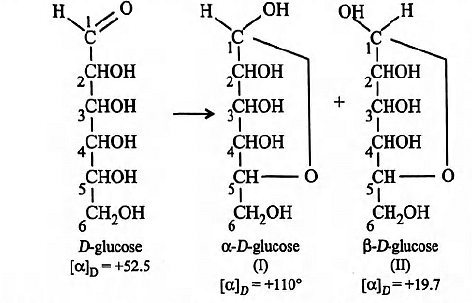The anomeric carbon in $D(+)$ glucose is
- C-1 carbon
- C-2 carbon
- C-5 carbon
- C-6 carbon
The Correct Option is A
Solution and Explanation

Carbon-$1$ in both configurations I and II is called an anomeric carbon atom.
Top Questions on Carbohydrates
- Lactose on hydrolysis give:
- CUET (UG) - 2023
- Chemistry
- Carbohydrates
- A young boy presents to the OPD with hypoglycemia and muscle cramps, on exertion or while playing. Then he becomes normal after resting for a while. These episodes are recurrent after a period of activity. He has decreased serum lactate and glucose levels. Which of the following diseases is he most likely to be suffering from?
- NEET PG - 2023
- Biochemistry
- Carbohydrates
- A 4-year-old child presents with easy fatigability. The mother also complains that the child has increased hunger between meals, which is relieved after food. Liver examination revealed no glycogen. The enzyme most likely deficient is?
- NEET PG - 2023
- Biochemistry
- Carbohydrates
- For the given reaction

The total number of possible products formed by tertiary carbocation of A is____.- JEE Main - 2023
- Chemistry
- Carbohydrates
- Expected products of hydrolysis of Lactose are:
- CUET (UG) - 2023
- Chemistry
- Carbohydrates
Questions Asked in JKCET exam
- A moving block having mass $m$, collides with another stationary block having mass $4\,m$. The lighter block comes to rest after collision. When the initial velocity of the lighter block is $v$, then the value of coefficient of restitution (e) will be
- JKCET - 2019
- work, energy and power
- A force $ F = 3x^2 + 2x + 1 $ acts on a body in the $ x $ -direction. The work done by this force during a displacement from $ x = -1 $ to $ +1 $ is
- JKCET - 2019
- work, energy and power
- What is the colour of the flame on heating potassium in the flame of a Bunsen burner?
- JKCET - 2019
- GROUP 1 ELEMENTS
- If $ a $ , $ b $ , $ c $ are the lengths of three edges of unit cell, $ \alpha $ is the angle between side $ b $ and $ c $ , $ \beta $ is the angle between side $ a $ and $ c $ and $ \gamma $ is the angle between side $ a $ and $ b $ , what is the Bravais Lattice dimensions of a tetragonal crystal?
- JKCET - 2019
- The solid state
- Which of the following compounds is known as copper glance?
- JKCET - 2019
- General Principles and Processes of Isolation of Elements
Concepts Used:
Carbohydrates
Carbohydrates, or carbs, are sugar molecules. Along with proteins and fats, carbohydrates are one of three main nutrients found in foods and drinks.
Your body breaks down carbohydrates into glucose. Glucose, or blood sugar, is the main source of energy for your body's cells, tissues, and organs. Glucose can be used immediately or stored in the liver and muscles for later use.
Classification of Carbohydrates
Carbohydrates are divided into two categories: simple and complex, based on their chemical structure and degree of polymerization.
Simple Carbohydrates (Monosaccharides, Disaccharides and Oligosaccharides)
One or two sugar molecules make up simple carbohydrates. Simple carbohydrates cause blood sugar levels to rise because molecules are easily digested and converted. Milk products, alcohol, vegetables, processed sugars, candies, and other foods contain a lot of them. These carbohydrates are referred to as "empty calories" because they lack fibre, vitamins, and minerals.
Complex Carbohydrates (Polysaccharides)
Starchy foods contain two or more sugar molecules and are thus referred to as complex carbohydrates. In comparison to simple carbohydrates, molecules in complex carbohydrates are digested and converted slowly. They are found in large quantities in potatoes, corn, cereals, lentils, peanuts, beans, whole-grain bread, peas, etc.
Carbohydrates can be found in the following examples:
- Glucose
- Galactose
- Maltose
- Fructose
- Sucrose
- Lactose
- Starch
- Cellulose
- Chitin



